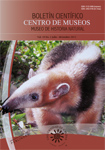Authors
Abstract
The natural environment is and has been modified according to human needs either by urbanization or for expansion of cultivation areas. Changes in areas coverage involve a transformation in their associated diversity. Insects are one the best studied groups in agricultural ecosystems but such knowledge is generally limited to pest species and their biological regulators. Butterflies have been used as an indicator group to assess the impact of management practices and habitat modification. This prompted the study of diurnal butterflies diversity associated with a citric agroecosystem in the canyon of the Cauca River, Colombia. The sampling yielded a record of 76 species represented mainly by the family Nymphalidae. This work contributes to the knowledge of the Colombian Lepidoptera and increases data distribution of diurnal butterflies in America.
References
BECCALONI, G. & GASTON, K.J., 1995.- Predicting the species richness of neotropical forest butterflies: Ithomiinae (Lepidoptera: Nymphalidae) as indicators. Biological Conservation, 71 (1): 77-86.
BROWN, J.K.S., 1997.- Diversity, disturbance, and sustainable use of Neotropical forests: insects as indicators for conservation monitoring. J. Insect Conserv., 1: 25-42.
CANADELL, J.G., CIAIS, P., DHAKAL, S., LE QUÉRÉ, C., PATWARDHAN, A. & RAUPACH, M.R., 2009.- The Global Carbon Cycle - 2. UNESCO-SCOPE-UNEP, Paris.
CASSON, A., 2003.- Oil Palm, Soybeans & Critical Habitat Loss. WWF Forest Conversion Initiative, Switzerland.
CONSERVATION INTERNATIONAL FOUNDATION, 2007.- Biodiversity Hotspots. Recuperado de http://www.biodiversityhotspots.org (última visita 23 enero de 2012).
FAO (Organización de las Naciones Unidas para la Agricultura y la Alimentación), 2009.- Situación de los bosques del mundo. Subdivisión de Políticas y Apoyo en Materia de Publicación Electrónica, División de Comunicación. FAO, Roma - Italia.
GALLINA, S., MANDUJANO, S. & GONZÁLEZ-ROMERO, A., 1996.- Conservation of mammalian biodiversity in coffee plantations of Central Veracruz, Mexico. Agroforestry Systems, 33 (1): 13-27.
GREENBERG, R., BICHIER, P. & STERLING, J., 1997.- Bird Populations in rustic and planted shade coffee plantations of Eastern Chiapas, Mexico. Biotrópica, 29 (4): 501-514.
HOLDRIDGE, L.R., 1967.- Life Zone Ecology. Tropical Science Center, San José.
LAMBIN, E.F., GEIST, H.J. & LEPERS, E., 2003.- Dynamics of land-use and land-cover change in tropical regions. Ann. Rev. Environ. Resour., 28: 205-241.
MUNYULI, T., 2011.- Assessment of indicator species of butterfly assemblages in coffee-banana farming system in central Uganda. Afr. J. Ecol., 50: 77-89.
PERFECTO, I., MAS, A., DIETSCH, T. & VANDERMEER, J., 2003.- Conservation of biodiversity in coffee agroecosystems: a tri-taxa comparison in southern Mexico. Biodiversity and Conservation, 12: 1239-1252.
PERFECTO, I. & VANDERMEER, J., 1994.- Understanding biodiversity loss in agroecosystems: Reduction of ant diversity resulting from transformation of the coffee ecosystem in Costa Rica. Trends in Agricultural Sciences, 2: 7-13.
PERFECTO, I., VANDERMEER, J., HANSON, P. & CARTIÂN, V., 1997.- Arthropod biodiversity loss and the transformation of a tropical agro-ecosystem. Biodiversity and Conservation, 6: 935-945.
PIN, L., 2008.- Can oil palm plantations be made more hospitable for forest butterflies and birds? Journal of Applied Ecology, 45: 1002-1009.
PINEDA, E., MORENO, C., ESCOBAR, F. & HALFFTER, G., 2005.- Frog, Bat, and Dung Beetle Diversity in the Cloud Forest and Coffee Agroecosystems of Veracruz, Mexico. Conservation Biology, 19 (2): 400-410.
PINHEIRO, C.E., MEDRI, Í.M. & SALCEDO, A.K., 2008.- Why do the ithomiines (Lepidoptera, Nymphalidae) aggregate? Notes on a butterfly pocket in central Brasil. Rev. Bras. Entomol., 52 (4): 610-614.
RAMANKUTTY, N. & FOLEY, J.A., 1999.- Estimating historical changes in global land cover: croplands from 1700 to 1992. Glob. Biogeochem. Cycles., 13 (4): 997-1027.
RÍOS-MÁLAVER, C., 2007.- Riqueza de especies de mariposas (Hesperioidea & Papilionoidea) de la quebrada "El Águila" Cordillera Central (Manizales, Colombia). Bol. Cient. Mus. Hist. Nat. U. de Caldas, 11: 272-291.
SEABROOK, L., MCALPINE, C. & FENSHAMB, R., 2006.- Cattle, crops and clearing: Regional drivers of landscape change in the Brigalow Belt, Queensland, Australia, 1840-2004. Landscape and Urban Planning, 28: 373-385.
VITOUSEK, P.M., MOONEY, H.A., LUBCHENCO, J. & MELILLO, J.M., 1997.- Human domination of Earth's ecosystems. Science, 277 (5325): 494-499.
WARREN, A.D., DAVIS, K.J., STANGELAND, E.M., PELHAM, J.P. & GRISHIN, N.V., 2012.- Illustrated Lists of American Butterflies. Recuperado de http://www.butterfliesofamerica.com (última visita septiembre de 2012).

 PDF (Español)
PDF (Español)
 FLIP
FLIP






















